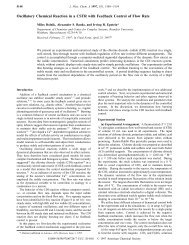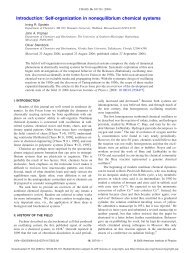Nonlinear Chemical Dynamics: Oscillations, Patterns, and Chaos
Nonlinear Chemical Dynamics: Oscillations, Patterns, and Chaos
Nonlinear Chemical Dynamics: Oscillations, Patterns, and Chaos
You also want an ePaper? Increase the reach of your titles
YUMPU automatically turns print PDFs into web optimized ePapers that Google loves.
<strong>Nonlinear</strong> <strong>Chemical</strong> <strong>Dynamics</strong> J. Phys. Chem., Vol. 100, No. 31, 1996 13139<br />
Figure 8. Stabilized period-2 limit cycle embedded in the strange<br />
attractor of the Belousov-Zhabotinsky reaction. Scattered blue points<br />
show chaotic trajectory in time-delay phase space; solid red curve shows<br />
period-2 limit cycle stabilized by using a map-based control algorithm.<br />
Measurements represent the potential of a bromide ion selective<br />
electrode. Reprinted with permission from ref 36. Copyright 1993<br />
Macmillan.<br />
information about mixed-mode, quasiperiodic, <strong>and</strong> chaotic<br />
behavior. 107 An intriguing notion advanced by Schell <strong>and</strong> coworkers<br />
108 is that cyclic voltammograms can be viewed as<br />
parametrically forced oscillators, with the accompanying complex<br />
periodic <strong>and</strong> chaotic oscillations. On varying the upper<br />
potential limit, scans with 2, 3, 4, etc. nonrepeating cycles are<br />
observed as well as aperiodic cycles.<br />
New techniques for manipulating dynamical systems, originating<br />
with the Ott-Grebogi-Yorke 109 (OGY) method for<br />
controlling chaos, have stimulated a flurry of experimental<br />
applications. 110 The OGY method provides a simple means for<br />
stabilizing unstable periodic states by supplying tiny but precise<br />
perturbations to the system. A chaotic attractor is made up of<br />
an infinite number of unstable periodic orbits, each saddlelike<br />
in character (in low-dimensional systems). It is straightforward<br />
to perturb the system in such a way that it relaxes in the<br />
attracting direction of the saddle, thus stabilizing the periodic<br />
state when such perturbations are repeated each cycle. The<br />
OGY method has been applied to a wide range of dynamical<br />
systems, with unstable periodic orbits stabilized in magnetoelastic<br />
strips, 111 electronic circuits, 112 <strong>and</strong> laser systems. 113<br />
A reduction of the OGY method based on a map description<br />
can be used for stabilizing low-dimensional systems. 114 Most<br />
of the experimental applications of control have used some form<br />
of this reduction, usually as simple proportional feedback. The<br />
map-based method was used for controlling chaos in the BZ<br />
reaction, 36 in which the regular oscillations of the period-1 <strong>and</strong><br />
period-2 orbits were stabilized out of the chaotic behavior.<br />
Figure 8 shows bromide electrode measurements of the stabilized<br />
period-2 limit cycle embedded in the chaotic attractor.<br />
Periodic states in a chaotic electrochemical system have been<br />
stabilized by Rollins <strong>and</strong> co-workers 115 using a recursive<br />
extension of the proportional feedback method. Hjelmfelt <strong>and</strong><br />
Ross 116 stabilized unstable steady states in the oscillatory<br />
chlorite-iodide reaction, where a control parameter was proportionally<br />
varied relative to a particular species concentration.<br />
A continuous feedback method proposed by Pyragas 117 has also<br />
been used to stabilize periodic oscillations in the BZ reaction. 118<br />
Feedback methods can be used not only to stabilize unstable<br />
states but also to track these states as operating conditions<br />
change. 119 By combining the map-based stabilization algorithm<br />
with a stability analysis subroutine, the locus of an unstable<br />
steady or periodic state can be determined as a function of the<br />
control parameter. This hybrid method has been used to track<br />
unstable orbits in the BZ reaction through a period-doubling<br />
sequence. 120 As in the previous methods, only tiny perturbations<br />
to the system are necessary to stabilize the states, <strong>and</strong> these<br />
states are therefore representative of the original autonomous<br />
system. Tracking also allows the stabilization of unstable states<br />
outside the chaotic regime, such as the unstable period-1 orbit<br />
in the stable period-2 regime. A particular unstable state can<br />
be followed through a complete bifurcation sequencesfrom the<br />
point it becomes unstable to the point it regains stability.<br />
Stabilizing <strong>and</strong> tracking states with more than one unstable<br />
direction remains an important challenge. Such states are<br />
common in spatially extended systems, <strong>and</strong> techniques beyond<br />
those developed for low-dimensional systems are required for<br />
controlling spatiotemporal chaos. A general method for stabilizing<br />
<strong>and</strong> characterizing states with many unstable degrees of<br />
freedom has recently been proposed, 121 where an explicit<br />
connection is made between phase space approaches, such as<br />
the OGY method, <strong>and</strong> classical linear control theory. The<br />
algorithm has been used to stabilize <strong>and</strong> characterize an unstable<br />
state found to have six unstable <strong>and</strong> three stable degrees of<br />
freedom. The method has also been used for stabilizing <strong>and</strong><br />
tracking unstable Turing patterns through spatiotemporal chaos. 122<br />
When coupled with the tracking technique, the stabilization<br />
algorithm provides a model-independent continuation method<br />
for bifurcation analyses of experimental systems, similar in<br />
capability to the continuation method AUTO 123 for model<br />
systems.<br />
VII. <strong>Chemical</strong> Waves<br />
Propagating fronts are ubiquitous in naturesjust imagine<br />
exp<strong>and</strong>ing bacteria colonies, advancing regions of metal corrosion,<br />
or infectious diseases spreading through populations.<br />
Many types of fronts, even those involving populations of<br />
microorganisms or individuals, can be formulated in terms of<br />
reaction-diffusion processes. Propagating reaction-diffusion<br />
fronts, 124 found in many autocatalytic <strong>and</strong> oscillatory reactions,<br />
serve as ideal model systems for such processes. Fronts<br />
typically propagate with a constant velocity <strong>and</strong> wave form,<br />
converting reactants that lie ahead into products which are left<br />
behind. The bulk of the chemical reaction occurs within a<br />
narrow reaction zone, similar to a propagating flamesbut with<br />
no heat.<br />
Reaction-diffusion fronts with quadratic nonlinearities have<br />
a long history, 3 first formally studied in 1937 by Fisher 125 <strong>and</strong>,<br />
independently, by Kolmogorov et al. 126 Quadratic fronts<br />
described by the Fisher-Kolmogorov equation have been the<br />
prototype over the years for propagating reaction-diffusion<br />
waves. It is now known, however, that quadratic nonlinearities<br />
cannot account for some features of propagating fronts, <strong>and</strong><br />
cubic or higher-order nonlinearities are sometimes essential.<br />
Insights into the similarities <strong>and</strong> differences of the quadratic<br />
<strong>and</strong> cubic forms can be gained by examining the mixed-order<br />
reaction-diffusion equation. 127 An important difference is that<br />
the cubic form yields an analytical solution for wave speed <strong>and</strong><br />
concentration profile, 128 while no analytical solution is known<br />
for the quadratic form. Fronts in the iodate-arsenite system,<br />
arising primarily from cubic autocatalysis, can be described in<br />
terms of an analytical solution of the corresponding reactiondiffusion<br />
equation. 19<br />
Many autocatalytic reactions are now known to support<br />
propagating fronts, <strong>and</strong> several have been characterized in terms<br />
of their reaction-diffusion equations. Fronts in the ferroin-





